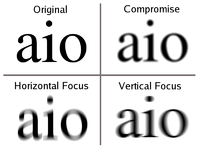
Photo from wikipedia
Abstract To evaluate surgically induced refractive change (SIRC) by manifest refraction and corneal power changes using an automated keratometer and Scheimpflug rotating camera, and to find the best keratometric measurements… Click to show full abstract
Abstract To evaluate surgically induced refractive change (SIRC) by manifest refraction and corneal power changes using an automated keratometer and Scheimpflug rotating camera, and to find the best keratometric measurements reflecting SIRC after hyperopic laser-assisted in situ keratomileusis (LASIK). This retrospective study included 18 eyes of 18 patients undergoing hyperopic LASIK using the Schwind Amaris 750S excimer laser. All measurements were performed preoperatively and 12 months postoperatively. Cycloplegic manifest refractions were performed and keratometric measurements were obtained via an RK-5 automated keratometer and a Pentacam rotating Scheimpflug camera. Sim K, true net power (TNP), and total corneal refractive power (TCRP) at 2.0 to 5.0 mm were analyzed using a Scheimpflug camera. The mean manifest refractive changes in the spherical equivalent (SE) at the corneal plane were 2.32 ± 1.65 D at 12 months postoperatively. The refractive power changes by the automated keratometer and Sim K were significantly less than SIRC (P = .043 and P = .048, respectively). Both TNP and the TCRP in the 5.0 mm zone produced lesser mean differences with SIRC (0.05 D and 0.06 D) and showed closer agreements with SIRC on Bland-Altman plots and higher correlation coefficients with SIRC. Corneal power measured on the anterior corneal surface underestimated SIRC. TCRP at the 5.0 mm zone provided by a Pentacam Scheimpflug camera reflected the SIRC accurately and precisely, and would be applicable for prediction of intraocular power before cataract surgery and follow-up measurement of corneal refractive power.
Journal Title: Medicine
Year Published: 2018
Link to full text (if available)
Share on Social Media: Sign Up to like & get
recommendations!